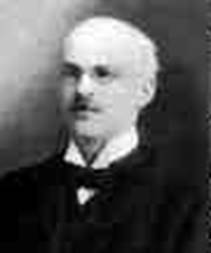
John Edward Campbell
 المؤلف:
Obituary of John Edward Campbell
المؤلف:
Obituary of John Edward Campbell
 المصدر:
Obituary of John Edward Campbell
المصدر:
Obituary of John Edward Campbell
 الجزء والصفحة:
...
الجزء والصفحة:
...
 21-3-2017
21-3-2017
 741
741
Born: 27 May 1862 in Lisburn, Co Antrim, Ireland
Died: 1 October 1924 in Oxford, Oxfordshire, England

John Campbell's father was also named John Campbell. He was a medical doctor who had a practice in Lisburn. John junior, the subject of this biography, was educated at home when he was young. He then entered the Methodist College in Belfast where he completed his school education before entering Queen's College, Belfast.
The Queen's University in Belfast had been established in 1845 and Campbell felt great loyalty towards this institution. As Elliott writes in [2]:-
He always remained a very loyal Ulsterman, in every sense, and expressed warm gratitude to those under whom he studied in his first university.
Campbell graduated from the Queen's University in 1884 and won a scholarship to study at the University of Oxford in England. He entered Hertford College, at that time a new College which had been founded in Oxford in 1874. He graduated in 1885 winning a Junior Mathematical University Scholarship in that year. He became a fellow of Hertford College in 1887, being awarded a Senior Scholarship in 1888, and was then appointed as a tutor at the College. He later was appointed as a lecturer at University College.
As to his success as a lecturer in Oxford Elliott, in [2], gives the following details:-
Of his devotion to duty in Oxford it is impossible to speak too highly, and the general affection felt for him can hardly be exaggerated. His success with pupils was marked, all the more marked because all saw that he was at home, mathematically, in regions above them, and wondered that he could come down to their modest level. He possessed capacity for administration also, serving his College well as Vice-Principal, with Principal's authority, and as Bursar, at times of special need.
He was also a strong advocate of women's education [1]:-
In the movement for women's education in Oxford he took a keen interest, and for several years recently was treasurer of Lady Margaret Hall.
Campbell's book Lie's Theory of Finite Continuous Groups (1903) introduced Lie's ideas to British mathematicians. However, he is most frequently remembered for the Campbell-Baker- Hausdorff theorem which gives a formula for multiplication of exponentials in Lie algebras. His research turned later towards differential geometry. Burnside gave the following appreciation of his work:-
Mr Campbell's interest in the theory of continuous groups was first shown in two papers on "A Law of Combination of Operators" in volumes 28 and 29 of the Proceedings of the London Mathematical Society. In these papers he deals, from a point of view which is essentially his own, with the formal results which are at the base of Lie's theory. In a paper published two years later "On the Theory of Simultaneous Partial Differential Equations" he develops a system of formulas by which it may be determined whether such a system is or is not integrable. His next contribution to the subject was a "Proof of the Third Fundamental Theorem in Lie's Theory". The proof given is essentially simpler than Lie's own; and, though it was subsequently criticised by Engel, it is recognised as being substantially complete. In 1903, not very long after the date of the last paper, Mr Campbell's "Introductory Treatise on Lie's Theory of Finite Continuous transformation Groups" was published. By writing this book he put English mathematicians under a lasting debt of gratitude. It gives a wonderfully clear and complete account of a modern theory which, although it already had a literature of its own on the Continent, had, at the time when the book was published, attracted little or no attention in this country. Moreover the book is not, in any sense whatever, a mere compilation from outside sources. It is full of points of view and illustrations which are Mr Campbell's own. The chapters on contact transformations and on differential invariants may be specially referred to. The theory in which Mr Campbell was so specially interested underlies most of his more recent work on differential geometry in general, and on that particular branch of it connected with Einstein's gravitational theory.
Campbell was elected a Fellow of the Royal Society in 1905. He had married Sarah Hardman, the daughter of a cotton spinner, in 1889. After one of their sons was killed in 1914 near Ypres during the fighting of World War I, Campbell seemed to give up mathematical research.
He was President of the London Mathematical Society from 1918 to 1920. He received an unusual tribute from the University of Cambridge when, shortly before his death, he was invited to examine the Mathematical Tripos at Cambridge, being the first Oxford mathematician to be asked to undertake this duty.
As to Campbell's personal character [2]:-
He was a man of singular personal charm, cheery, unaffected, trust-inspiring. There was no selfishness in him. Differences of opinion, where principle was not at stake, did not worry him. He knew how to be sorry without complaining if misfortune or disappointment came his way.
He is described in [1] as follows:-
Naturally modest and rather shy in manner, he was never a very prominent figure in University business or society, but he was greatly liked by his pupils and loved by those who knew him well. ... His high character and unselfishness made him much respected both in the college and in the University.
Articles:
- Obituary of John Edward Campbell, Proc. Roy. Soc. London A 107 (1925), ix - xii.
 الاكثر قراءة في 1860to1864
الاكثر قراءة في 1860to1864
 اخر الاخبار
اخر الاخبار
اخبار العتبة العباسية المقدسة


